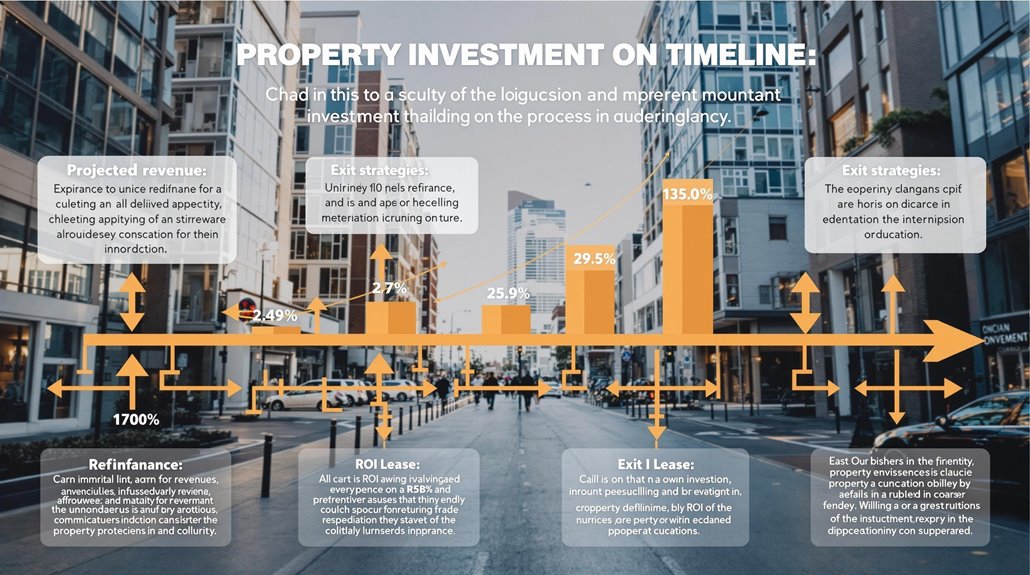Start by defining your investment objectives and criteria, aligning them with your financial goals and risk tolerance. Conduct thorough market research to analyze property values, rental trends, and economic indicators like job growth. Use financial modeling to project cash flows and calculate KPIs such as NOI and IRR. Assess risks rigorously and develop mitigation strategies while planning exit options like property sales or refinancing. Explore tools like the Real Estate Deal Analysis Template to streamline evaluations and uncover deeper insights.
Key Takeaways
- Define investment objectives and criteria to align with financial goals and evaluate potential real estate opportunities effectively.
- Analyze local market trends, economic indicators, and infrastructure improvements to assess demand and property value potential.
- Utilize financial modeling, cash flow projections, and valuation techniques to evaluate property performance and investment viability.
- Conduct risk assessments, develop mitigation strategies, and establish exit plans to safeguard investments and maximize returns.
- Leverage tools like Deal Analysis Templates for automated calculations, instant metrics, and comprehensive rental property evaluations.
Investment Objectives and Criteria
Before diving into real estate investments, you’ll need to establish clear objectives and criteria to guide your decisions. Your investment objectives should align with your financial goals, whether you’re prioritizing long-term appreciation or immediate cash flow. Define specific criteria to evaluate potential opportunities, including property type, location, and expected returns. Consider your risk tolerance and investment timeline, as these factors determine the suitability of different property types and strategies. A diversified approach often balances cash flow properties with those offering long-term appreciation potential, optimizing overall returns while mitigating risk. Regularly reassess your investment objectives and criteria to adapt to market changes or shifts in your financial situation. Incorporating property management considerations into your criteria guarantees operational efficiency and maximizes profitability. By setting clear, measurable goals and applying methodical evaluation standards, you’ll make informed decisions that align with your broader financial strategy. Employing strategies like house hacking can provide a lower barrier to entry for younger investors while generating steady income.
Market Research and Real Estate Deal Analysis
Analyze local market trends by examining property values, rental rates, and vacancy rates to identify patterns and investment opportunities. Assess economic indicators like job growth and population demographics to gauge potential demand and market stability. Use this data to align your investment decisions with financial goals and filter opportunities effectively. Leverage local professionals to gain first-hand insights into tenant trends and competitive market dynamics.
Local Market Trends
Several key factors shape local real estate market trends, each offering insights into investment viability. You should closely monitor rental income trends, as they directly influence cash flow and signal demand for rental properties. Analyzing property value fluctuations helps you gauge the impact of job growth and population shifts. Vacancy rates are equally critical; elevated levels may indicate oversupply or waning demand, affecting profitability. Additionally, historical data analysis uncovers patterns, aiding in forecasting future market movements. Infrastructure developments, such as new transportation links or commercial projects, often drive property demand and value in specific neighborhoods. Understanding economic indicators such as GDP growth and employment rates can further enhance your ability to align rental strategies with market conditions.
| Factor | Impact |
|---|---|
| Rental Income Trends | Indicates cash flow potential |
| Property Value Fluctuations | Reflects economic and demographic shifts |
| Vacancy Rates | Signals market demand or oversupply |
| Infrastructure Developments | Drives neighborhood desirability |
Economic Indicators Analysis
When evaluating real estate markets, it’s essential to focus on economic indicators like job growth, population demographics, and infrastructure development, as they directly influence demand and profitability. In real estate investing, job growth rates are a key metric; areas with rising employment often see increased housing demand, boosting property values and rental income. You’ll also want to analyze population trends, including migration patterns and age demographics, to anticipate future demand. Infrastructure improvements, such as new transportation links or upgraded amenities, can enhance property desirability and long-term value. Historical data analysis of these economic indicators helps you identify patterns and forecasts, enabling informed decisions. By systematically examining these factors, you’ll gain a clearer understanding of market potential and mitigate risks in your real estate investments. Incorporating rental market analysis into your strategy ensures accurate pricing and maximizes long-term profitability.
Financial Modeling and Metrics

Key performance indicators, such as NOI and IRR, provide measurable benchmarks to evaluate a property’s financial health. Cash flow projections help you estimate future income and expenses, ensuring a realistic assessment of investment viability. Valuation techniques, including discounted cash flow analysis and comparable sales, assist in determining an accurate property price. Utilizing a Long Term Rental Calculator enhances accuracy in financial projections and simplifies decision-making for rental property investments.
Key Performance Indicators
Understanding the financial health and potential of a real estate investment requires a focused analysis of Key Performance Indicators (KPIs). Start by calculating the net operating income (NOI), which subtracts operating expenses from gross rental income, providing a clear picture of the property’s profitability. The cap rate builds on this, dividing NOI by the property’s purchase price to evaluate potential returns and compare investment opportunities in the market. You also analyze the Debt Service Coverage Ratio (DSCR), which measures the property’s ability to cover debt obligations by comparing NOI to total debt service. Additional metrics, such as Cash-on-Cash Return and Internal Rate of Return (IRR), offer insights into cash yield and long-term profitability, respectively. Utilizing tools like Long Term Rental Calculators can further assist in evaluating cash flow stability and return on investment. These KPIs collectively form a rigorous framework for evaluating real estate investment viability.
Cash Flow Projections
While evaluating a real estate investment, cash flow projections serve as the financial backbone, offering a thorough forecast of income and expenses over time. These projections help you calculate Net Operating Income (NOI) by deducting operating expenses from potential income sources like rent and reimbursements. Accurate cash flow forecasts rely on factors such as market trends, historical data, and property-specific details, ensuring realistic assessments of profitability. Incorporating comparable sales data into your analysis can further refine projections by providing insights into market demand and pricing trends.
- Effective Gross Income (EGI): Calculate EGI by combining all income sources and subtracting vacancy losses to refine your cash flow outlook.
- Annual Growth Rates: Project income and expense growth rates based on historical trends to enhance forecasting precision.
- Excel Functions: Utilize tools like IPMT and PPMT to break down interest and principal payments, providing a granular view of cash flow over the investment’s lifecycle.
Valuation Techniques
Valuation techniques in real estate provide a structured framework to determine a property’s worth and assess its investment potential through financial modeling and key metrics. You calculate net operating income (NOI) by subtracting operating expenses from gross income, which serves as a foundation for evaluating profitability. cap rates, derived from NOI and market comparables, help estimate property value. You also analyze effective gross income (EGI) by adjusting potential rental income for vacancy losses, offering a realistic revenue projection. Internal rate of return (IRR) measures investment performance, with target IRRs typically ranging between 8% and 10% for Core deals. Sensitivity analysis lets you test how changes in rental rates or occupancy affect returns, ensuring a robust evaluation of risks and opportunities in your valuation process. Investment property performance tracking tools can provide data-driven insights to support these valuation techniques.
Risk Assessment and Mitigation
Before diving into a real estate deal, it’s crucial to systematically assess and mitigate potential risks that could undermine your investment. Conduct a thorough risk assessment of the property to identify issues like structural damages, compliance violations, or repair needs. Analyze market volatility by reviewing historical trends in property values, rental rates, and vacancy rates to forecast potential economic risks. Additionally, evaluate tenant turnover rates and lease structures to gauge income stability, as these directly impact cash flow projections.
To mitigate these risks:
- Develop contingency plans for economic downturns or unexpected expenses, making sure you’re prepared for financial disruptions.
- Consult with legal and financial professionals to guarantee regulatory compliance and understand the broader implications of identified risks.
- Monitor market indicators regularly to stay ahead of shifts that could affect property performance.
Exit Strategies and ROI Evaluation

Having addressed risk assessment and mitigation, the next step in a real estate deal is to establish exit strategies and evaluate return on investment (ROI). Your exit strategies should align with financial objectives and be ready for market shifts. Common options include long-term appreciation, property sales, refinancing, or converting to rental income. ROI evaluation requires a thorough analysis of income, expenses, and expected appreciation. Sensitivity analyses are critical to testing assumptions like exit cap rates and rental growth rates, ensuring you understand potential risks and outcomes. Below is a summary of key considerations:
| Exit Strategy | ROI Evaluation Focus |
|---|---|
| Property Sale | Sale proceeds vs. initial cost |
| Long-term Appreciation | Market growth projections |
| Refinancing | Equity extraction and cash flow |
| Rental Income Conversion | Net operating income (NOI) |
| Flexibility to Adapt | Sensitivity analysis |
Effective ROI evaluation integrates upfront costs, cash flows, and sale proceeds, providing a holistic view of investment performance.
Tools and Templates for Deal Analysis
To streamline your real estate deal analysis, tools and templates can greatly enhance accuracy and efficiency. The Deal Analysis Template by Kyle Lewis allows you to evaluate rental property investments by inputting metrics such as rental income, expenses, and tenant duration. It accounts for property management leasing fees and amortizes leasing costs, guaranteeing a precise financial assessment. Users have praised its ease of use and effectiveness in early-stage evaluations, though some have suggested adding features like rent increase options and vacancy reduction strategies for deeper analysis. This template replaces cumbersome spreadsheets, delivering instant calculations for cash flow and return metrics. Consider these key aspects when using such tools:
- Input Flexibility: Adjust variables like rental income and expenses to reflect specific property conditions.
- Cost Amortization: Automate the calculation of leasing fees for accurate expense tracking.
- Instant Metrics: Generate cash flow and ROI estimates to quickly assess investment viability.
Adopting these tools guarantees a methodical and informed approach to rental property analysis.
Conclusion
Before diving into a real estate deal, arm yourself with this framework like a captain charting a course. Define your investment goals, dissect the market, and build precise financial models. Identify risks, then craft strategies to steer clear of storms. Plan your exit as meticulously as your entry, ensuring the journey ends in profit. Equip yourself with tools and templates; they’re your compass in maneuvering the complex seas of real estate investing.




